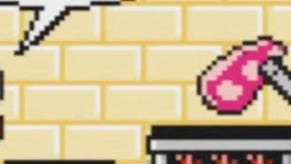Fable III
Rule of fun.
"If I'm playing with my girlfriend, I can get married to my girlfriend in the game," says Timmins. "Have a wedding, get down on one knee like in real life. When you actually get married in the game, you have a shared bank account. So one day you might turn your game on thinking yeah, I've got 1000 gold, I can have that weapon that I wanted, you run over you press A, you've got no money. The reason is, you go to your house, you've got pink wallpaper and a new bed."
On to Shadelight Dungeon. This thoroughly spooky cavern is situated on the new continent of Aurora, a Middle Eastern desert land as stark and mysterious as Albion is bucolic and friendly. You land here after a shipwreck, your vessel destroyed by a cannonball during an escape from the tyrant Logan who you're trying to depose.
It's hauntingly beautiful. Outdoors, sandswept dunes and crags under a glowering sun would be the most spectacular desertscape of E3 if it wasn't for Journey, but it's a close run thing. In Shadelight, the huge, misty spaces of the cavern are populated with crowds of pure black shadow beings with glowing eyes and fantastical, vaguely Egyptian monsters that steer refreshingly clear of fantasy norm. Bearing in mind the industrial and pastoral moods we've already seen, Fable III is clearly exploring a much wider tonal range than its predecessors, in terms of its art at least.
We've already heard about the weapons that will grow in power and morph with your hero according to your actions and decisions. As with everything in Fable III, including your own hero's levelling and status - even the health bar relegated to an action-game-style desaturation effect - this happens organically and is translated into in-game effects rather than interface readouts.

"There's no convoluted level-up screens, there's no having to spend experience on certain things; it all happens in the background, it's all subliminal," says Timmins. "When your weapon becomes more powerful, the hero stands up, throws his weapon in the air, everything goes into slow motion, and it blasts all the enemies away."
"We actually call it the Greyskull moment, as in Castle Greyskull," says Eckersley.
Combat's had a complete overhaul: although Lionhead likes the simplicity of Fable II's "one-button" combat, they felt it was sluggish and clumsy, especially when switching weapons. Now, with ranged and melee attacks mapped to separate buttons, combo attacks, slow-mo finishes and swift animation transitions, it feels even more like a third-person action game, albeit one that's played at a slightly more relaxed pace. The timing could be more crisply defined, but there's plenty of time for Lionhead to refine that.
Given how solid and sleek and comprehensive this demo of Fable III is, that's a reassuring thought indeed. There's every sign that one of Molyneux's two great ambitions for the game - to make a sprawling, emergent RPG as approachable and slick as the most mass-market action game - will be realised. On the other ambition, its political dimension, we'll have to accept his promises for now. This time, though, we're inclined to take them on trust.
Fable III will be released on 26th October, simultaneously for Xbox 360 and PC.
















